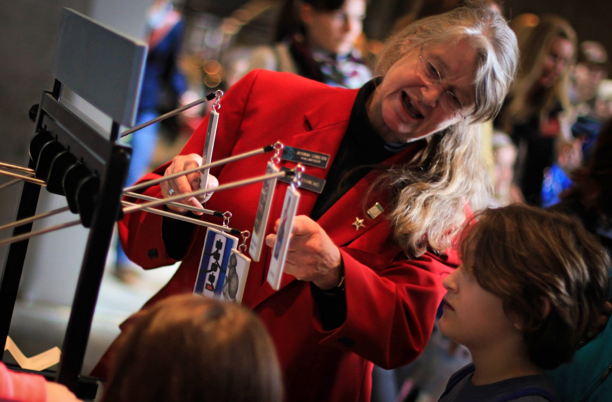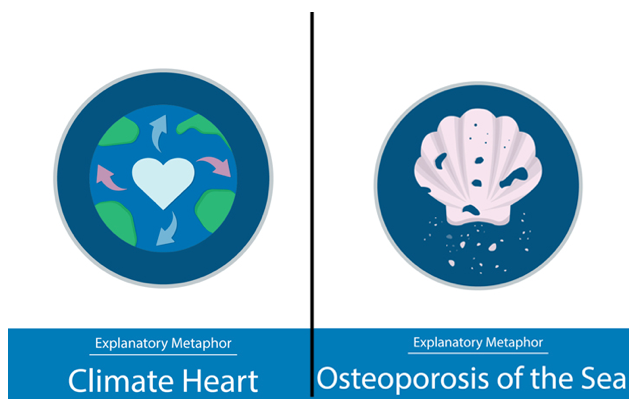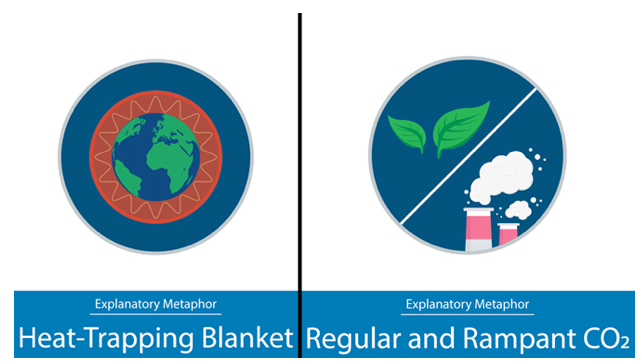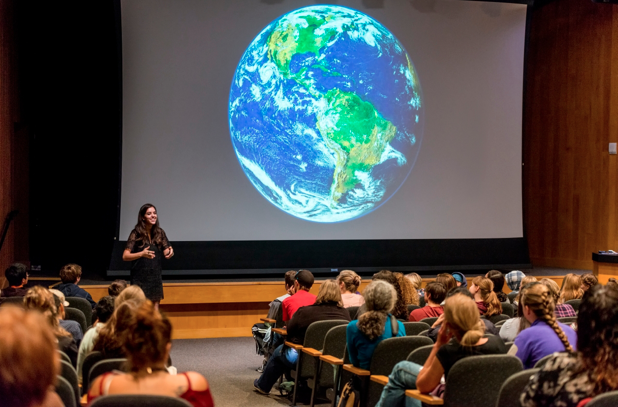Metaphors Can Counter Misinformation about Climate Change

This is the fifth post in a series about framing ocean and climate change.
Our ability to communicate the science of climate change to the public is as important as ever. The outcome of the recent presidential and congressional elections and the state of public discourse around the environment reflect and reinforce misunderstanding and skepticism of climate change. Polls show that Americans are unsure of its causes and consequences, and many don’t trust scientific information about it. Our work, in short, is cut out for us.
The good news: Research shows that “explanatory metaphors”—linguistic devices that simplify complex concepts and facilitate understanding of social issues—can help.
The FrameWorks Institute, a communications think tank in Washington, DC, teamed up with the National Network for Ocean and Climate Change Interpretation (NNOCCI) to develop an evidence-based strategy to communicate—or frame—climate and ocean change. This meta-narrative has the power to help the public understand climate change, correct misinformation about it, and boost support for the systemic solutions needed to address it.

To conduct the research, FrameWorks interviewed experts and members of the public about climate and ocean change and compared the differences in understanding between them. The findings—and their implications for advocates and experts—were summarized in the first and second posts in this series. FrameWorks also designed and tested frames and frame elements that enhance public understanding and motivate people to take action to support systemic solutions. These findings were summarized in the third and fourth posts in this series.
This post explores findings related to a set of explanatory metaphors—Heat-Trapping Blanket and Regular & Rampant Carbon Dioxide—that FrameWorks developed to explain the causes of climate change and to guide thinking to support for the systemic changes needed to address it. Advocates and experts can use these metaphors to navigate a number of cultural models—widely shared beliefs and understandings about how things work—that are at odds with the science of climate change.

Americans, for example:
· Are unlikely to name fossil fuel use as the underlying cause of climate change;
· Confuse the cause of climate change with “the hole in the ozone layer” and confuse carbon dioxide with carbon monoxide; and
· Assume that because carbon dioxide is “natural,” it can’t be harmful to the environment.
These models have significant implications for those advocating for solutions to climate change. For example, people haven’t heard of ocean acidification, but once they do, they assume it is caused by “unnatural pollutants” rather than rising levels of carbon dioxide, the main cause of the problem. This undermines support for solutions that have the potential to make real and lasting change. As another example, people tend to lump climate change with other environmental challenges, and therefore support solutions like recycling and turning out the lights but not necessarily the systematic or policy solutions that “match” the size, scale, and scope of the problem. These models also contribute to fatalistic attitudes about climate change—that the problem is too big to fix.
FrameWorks has found that Heat-Trapping Blanket and Regular & Rampant CO2 can overcome these models. They engage the public and encourage productive thinking about how climate change works and the large-scale solutions needed to address it.
Comparing global warming to a blanket focuses people’s attention on the underlying causes and mechanisms of climate change. It is also “stickier”—or more memorable—than comparing it to a “greenhouse” gas, the dominant metaphor in the field. FrameWorks found that people were more likely to repeat and reason about climate change using language from the blanket domain than with language related to greenhouses. An example of the metaphor follows:
When we burn fossil fuels for energy, such as coal, oil, or natural gas, we release carbon dioxide into the atmosphere. Carbon dioxide is a gas that traps heat. As CO2 builds up, it acts like a blanket, trapping in heat that would otherwise escape. This “blanket effect” is warming the planet’s atmosphere, disrupting the balance that keeps the climate stable.

Despite the metaphor’s strong frame effects, subsequent research showed that advocates needed an additional tool to reframe public understanding of carbon dioxide. People were having difficulty reconciling its essential role in human, plant, and animal life with its disruptive role in the climate. Moreover, the blanket metaphor did not help people understand the problem of ocean acidification. To address these problems, FrameWorks developed a taxonomy that compares normal levels of carbon dioxide with anthropogenic carbon dioxide:
Some carbon dioxide, or CO2, is needed for life processes. We can call this “regular CO2.” But CO2 is not just something that we breathe out and plants take in. It’s also something that gets put into the air when we use any kind of fossil fuel—when we burn coal to create electricity, or use oil to fuel transportation or manufacturing. These things are putting a lot of CO2 into the atmosphere and oceans. We can call this Rampant CO2 because there’s too much of it and it’s getting out of control. Rampant CO2 accumulates in places like the ocean, and causes a number of problems in the climate and ecosystems. There will always be regular levels of carbon dioxide, but we need to start reducing rampant levels of carbon dioxide.
This comparison helped people understand the difference between normal and harmful levels of carbon dioxide. People were able to grasp an important nuance between the role of CO2 in respiration and photosynthesis and its role in trapping heat in the planet’s atmosphere. The metaphor also improved understanding and attitudes related to the climate system and ocean acidification. One important note: FrameWorks advises communicators to fully explain the taxonomy of carbon dioxide rather than to simply use the word rampant as an adjective.
This pair of tools offers communicators thoroughly tested ways to establish a sound causal understanding and head off dominant misconceptions about climate change. The sixth and final post in this series will address a last frame element: solutions-oriented discussions.
For more information about how and why these metaphors advance and enhance environmental communications, read How to Talk about Climate Change and the Ocean; download these “reframe cards” for a summary of tested frame elements; and watch a short video of reframes in action. Click here for more resources about effective environmental communications frames.
More Blog Posts
 Of Penguins & Solar PanelsOf Penguins & Solar Panels by Billy Spitzer, August 28 2018 Here’s a surprising penguin fact: much like our own communities, African Penguins and the ecosystems they’re part of benefit from our transition away from fossil fuels and toward renewable energy. Like many people, we at the New England Aquarium believe in safeguarding people and [READ MORE]
Of Penguins & Solar PanelsOf Penguins & Solar Panels by Billy Spitzer, August 28 2018 Here’s a surprising penguin fact: much like our own communities, African Penguins and the ecosystems they’re part of benefit from our transition away from fossil fuels and toward renewable energy. Like many people, we at the New England Aquarium believe in safeguarding people and [READ MORE] The Science of ExtremesThe Science of Extremes by Richelle Tanner, July 13 2021 Extreme is a word that can send a climate communicator directly into the swamp: the word extreme is inherently a bit alarming, and vague enough to warrant a multi-sentence qualification when you use it. Even scientists disagree on what this word means and in which context it is appropriate. [READ MORE]
The Science of ExtremesThe Science of Extremes by Richelle Tanner, July 13 2021 Extreme is a word that can send a climate communicator directly into the swamp: the word extreme is inherently a bit alarming, and vague enough to warrant a multi-sentence qualification when you use it. Even scientists disagree on what this word means and in which context it is appropriate. [READ MORE] National Network for Ocean and Climate Change Interpretation (NNOCCI) Impacts After 5 YearsNational Network for Ocean and Climate Change Interpretation (NNOCCI) Impacts After 5 Years by Sarah-Mae Nelson, MS, CIG/CIT, February 13 2016 Since 2009, the National Network for Ocean and Climate Change Interpretation—better known as NNOCCI—has been a collaborative effort to raise the discourse around climate change and ocean acidification. Led [READ MORE]
National Network for Ocean and Climate Change Interpretation (NNOCCI) Impacts After 5 YearsNational Network for Ocean and Climate Change Interpretation (NNOCCI) Impacts After 5 Years by Sarah-Mae Nelson, MS, CIG/CIT, February 13 2016 Since 2009, the National Network for Ocean and Climate Change Interpretation—better known as NNOCCI—has been a collaborative effort to raise the discourse around climate change and ocean acidification. Led [READ MORE] Communicating in the Swamp: How to Navigate Public Thinking About Climate and Ocean ChangeCommunicating in the Swamp: How to Navigate Public Thinking About Climate and Ocean Change July 22 2016 This is the first in a series about framing ocean and climate change. When people think about oceans this summer, they might think of a good vacation spot—a place to spread out the beach towel, pop up the umbrella, and relax under the sun as [READ MORE]
Communicating in the Swamp: How to Navigate Public Thinking About Climate and Ocean ChangeCommunicating in the Swamp: How to Navigate Public Thinking About Climate and Ocean Change July 22 2016 This is the first in a series about framing ocean and climate change. When people think about oceans this summer, they might think of a good vacation spot—a place to spread out the beach towel, pop up the umbrella, and relax under the sun as [READ MORE] Attention Environmental Advocates: Avoid ‘Cute Critters’ and other Communications TrapsAttention Environmental Advocates: Avoid ‘Cute Critters’ and other Communications Traps August 09 2016 This is the second in a series about framing ocean and climate change. A fuzzy polar bear cub against an expanse of melting snow. A seal pup slicked in oil. A newborn orangutan clutching its mother’s breast as she swings through a disappearing [READ MORE]
Attention Environmental Advocates: Avoid ‘Cute Critters’ and other Communications TrapsAttention Environmental Advocates: Avoid ‘Cute Critters’ and other Communications Traps August 09 2016 This is the second in a series about framing ocean and climate change. A fuzzy polar bear cub against an expanse of melting snow. A seal pup slicked in oil. A newborn orangutan clutching its mother’s breast as she swings through a disappearing [READ MORE]